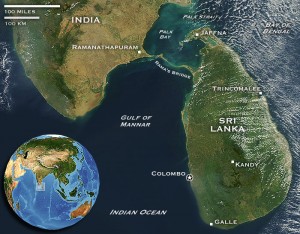Conservation often finds support from the strangest corners.
In the case of the Sethusamudram Shipping Canal Project, it was the Hindu holy epic The Ramayana that managed to stall the project that conservationists have been opposing for years. The Ramayana, speaks of the ordeals of the Indian prince Rama, and reaches a climax with the godly prince waging a war against the mighty king of Sri Lanka, Raavana, who abducted his wife.
In the Ramayana, Rama made his way to Lanka by building a bridge across the waters separating India and Sri Lanka, called the RAM SETHU. Its geographical homologue is the Adam’s Bridge, a chain of limestone shoals connecting the Rameshwaram Island of India to the Mannar Islands in the North Eastern coast of Sri Lanka.
The Adam’s Bridge lies in the Gulf of Mannar Biosphere Reserve, home to more than 4200 species of flora and fauna, a tenth of which are endemic to the region. Impacts of the project would also be felt in the Palk Bay region, where extensive sea grass meadows are found. These meadows harbor diverse fish stocks and are important feeding grounds for dugongs and turtles. The dredging would also affect the functioning of a number of marine flora and fauna resulting in widespread destruction of a number of species, most of which are protected.
The shallow waters of the Sethusamudram (“Sea of Sethu”) provide an obstruction to navigation between the Gulf of Mannar and the Palk Strait. Larger vessels need to navigate around Sri Lanka to the reach the eastern coast of India. Initial proposals and efforts to dredge the Sethusamudram, date back to the late 18th and 19th centuries. Since then, the $410 million Sethu Samudram Shipping Canal Project has been an important feature on the election manifestoes of a number of political parties. The Congress, in 2008, under then Prime Minister Dr.Manmohan Singh, established a 6-member committee headed by Dr. Rajendra Pachauri, chairman of the Intergovernmental Panel on Climate Change (IPCC) to come up with a feasible plan.
Dr. Pachauri’s report advised against the implementation of the Sethu Samudram Shipping project. This report was overlooked by the then-government, which decided to go ahead with the project claiming economic, navigational and strategic advantages. The blockade, however, came in the form of a religious argument claiming the project would demolish the Ram Sethu.
To build this canal, the limestone shoals of the Adam’s bridge had to be destroyed- an idea that did not go down well with Hindu secularists. Petitions were filed in the Supreme Court of India to stay the dredging till alternative routes were found. The Indian government reacted by filing a response from the Archeaological Survey of India, saying the Adam’s Bridge was a natural formation and that mythological texts cannot be the basis for governmental policy. The issue came to standstill.
The original oppositions against this project, namely the ecological, environmental and social impacts, have been completely overlooked.
Religion, in this case, appears to be in favour of the scientific community.
References:
1. Ramesh, R. 2005. Sethusamudram Shipping Canal Project. Current Science 88:536-537.
2. Rodriguez, S., John, J., Arthur, R., Shanker, K., and Sridhar, A. (2007). Review of the Environmental and Economic Aspects of the Sethusamudram Ship Canal Project. Available online at: http://seaturtlesofindia.org/wp-content/uploads/2014/02/Rodriguez-et-al_SSCP_GoMBRT_2007.pdf
3. S. Rodriguez. A mockery of science, conservation and environmental laws. The Hindu. May 19th, 2008.
4. J.Venkatesan.Centre rejects Pachauri panel report, wants Sethusamudram project implemented. The Hindu. Semptember 17th, 2013.

